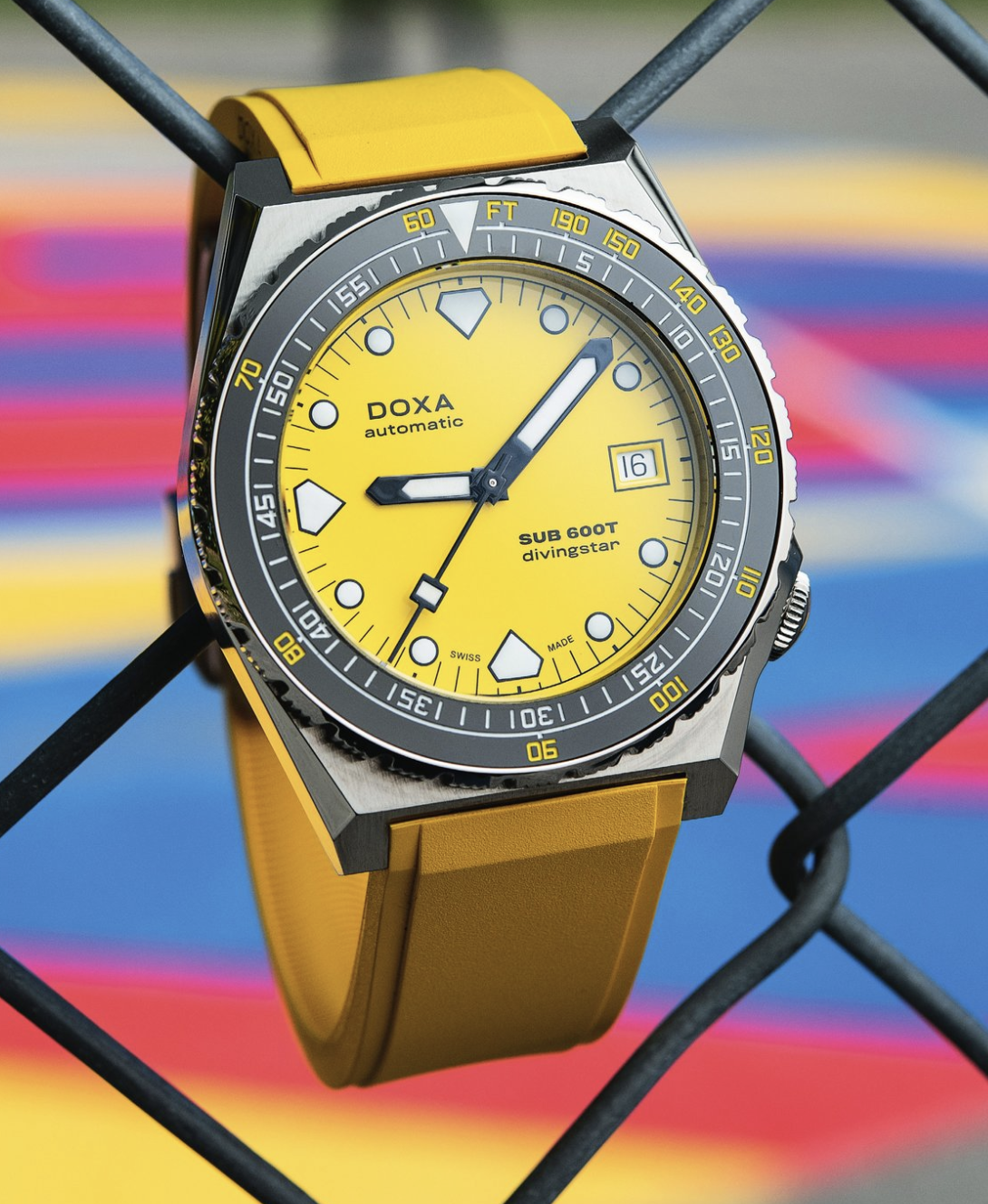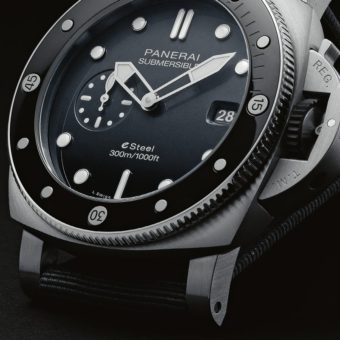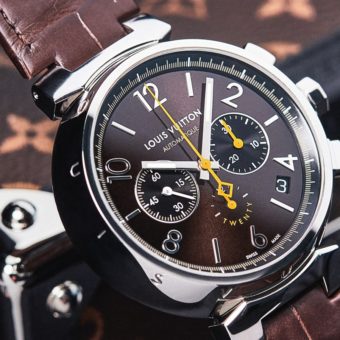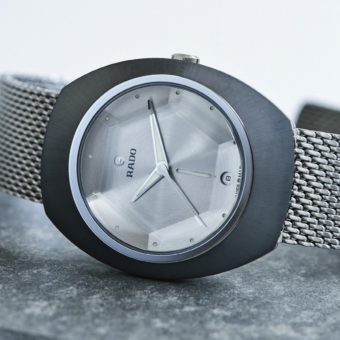This article was originally published in the March/April 2022 Issue of the WatchTime print magazine.
In 2021, Doxa added the latest member to its already extensive dive watch catalog, the 1980s-inspired Doxa Sub 600T with a rather unique angular case design. WatchTime went hands-on with a pre-production model.

Back in August 2021, Doxa launched a (quickly sold-out) 200-piece limited “Pacific” edition of the Sub 600T in titanium with blue dial (Ref. 861.50.231.33). Three months later, the Swiss watch brand announced the release of the full-rainbow color palette, this time as a regular extension of the Sub-themed collection of dive watches and exclusively available in stainless steel. Even though Doxa currently offers 25 versions of the Sub 600T re-edition, the new collection is in reality much easier to decode than the number of references might suggest. First of all, Doxa traditionally names all its dial colors individually. There are the “Professional” (the brand’s quintessential orange), “Sharkhunter” (black) and “Searambler” (silver) dial versions from the ’60s, followed by the “Divingstar” (yellow) and the more recent “Caribbean” (blue) and “Aquamarine” (turquoise) versions. All six dial colors can be combined with a choice of two bezels, either with a sandblasted steel insert or a black ceramic insert (both with the dual scale for the dive time and depth).
Additionally, the current Sub 600T is available with either a tone-on-tone rubber strap to match the dial color or a new 316L stainless-steel bracelet with folding clasp. The FKM rubber (short for fluro-elastomer) strap also features a new, comparatively compact folding clasp. Combined, these options add up to 24 different reference numbers, the 25th being reserved for the aforementioned “Pacific” edition that was only available in one configuration. Ironically, compared to the original model from the ’80s, this number represents a significant reduction of versions.

In 1978, a time in which the Swiss watch industry was still in a significant consolidation phase, Doxa’s stint with the Neuchâtel-based Synchron group came to an end, and it became part of the brand portfolio of Aubry Frères S.A. in Le Noirmont, Switzerland. “Aubry of Switzerland” focused on Dogma, West End, Ernest Borel and Doxa as “leaders in their markets.”
During that period with Aubry, Doxa quickly started to expand and modernize its range of dive watches with the introduction of the Sub 600 and 1000 models, both offering increased water resistance (compared to the majority of its cushioncased predecessors), an asymmetrical angular case with the crown at 4 o’clock, and a new bracelet design. Interestingly, Doxa briefly offered an almost identical quartz version in 1981 with the crown at 3 o’clock (Ref. 4271).

For the Sub 600 and 1000 models, Doxa had both quartz and mechanical movements in store, and at least five types of bezel inserts, with or without decompression scale (one of them was even a two-tone “Pepsi” version), as well as a smaller women’s version with a similar design (Sub 200T). Surprisingly, the brand’s traditional colorcoding system started to erode with this model, with the name “Professional” eventually appearing on more than one non-orange dial. Speaking of dials, Doxa offered the ’80s model with a choice of at least three dial layouts: one with regular bars, the shark-tooth design shown here and one with a combination of triangles and bars. Last but not least, watches with this type of case also came as “T” (for Tritium), “Lm” or “La Spirotechnique” editions, to name a few.
Even though the ’80s marked a transitioning time for both the watch industry and the diving community (in 1983, the Orca Edge hit the market as the first commercially viable dive computer), Doxa Subs of that period were still highly popular among divers. On June 16 in 1983, for example, two French divers set a new record during operation “Entex 9” in the hyperbaric center of the Marine Nationale in Toulon, France, after having spent one and a half hours underwater at a simulated depth of 613 meters. In total, Patrick Raude (Compagnie maritime d’expertises COMEX) and Claude Ohrel (Groupe d’Intervention Sous la Mer GISMER) had spent 42 days in the pressure chamber. With them: at least one quartzpowered Sub 1000 from Doxa that had “performed perfectly,” according to Marcel Aubry, then President of Aubry Frères.

The current re-editions of the Sub 600T are all equipped with the same type of dial, with large diamond-shape markers at 12, 6 and 9 o’clock, dots at each of the other hour positions, a3 o’clock date window (with white date disk), and off-center positions for the brand and model name. Doxa uses the almost identical set of hands that can be found throughout the current Sub 300-range, but here (similar to the original model from the ’80s), the hour hand is significantly larger, creating a much more balanced look. Also worth noting: The hands on the Aquamarine, Divingstar, Searambler and Professional versions are covered with black lacquer; the Sharkhunter and Caribbean versions come with white hands for the hours and seconds, the minute hand is orange. The hour markers on the Sharkhunter, Searambler and Caribbean models feature an orange outline; the Professional, Divingstar and Aquamarine come with black outlines. T he case (40 mm in diameter and 14.15 mm in height) is brushed, with the sides featuring large polished chamfers. Even though the Sub 600T is not a particularly small watch, it looks comparatively compact on the wrist (it’s 47.60 mm lugto-lug). The dial, on the other hand, appears bigger than on the cushion shaped models, due to the larger opening and flat sapphire crystal.

As its name indicates, the Sub 600T is water resistant to 600 meters, thanks to its screwed steel caseback and screw-down crown, both of which come with the Doxa fish symbol (a nod to the current owner of the brand, the Jenny family). A nice detail: the fish logo on the crown matches the dial color. There is turquoise (Aquamarine), orange (Caribbean, Searambler, Sharkhunter and Professional) or yellow (Divingstar) for the insert. Inside the case, the Sellita SW200-1 operates with 28,800 vibrations per hour (4 Hz).
The overall design of the 600T is surprisingly contemporary (after all, we’re talking about a more than 50-year-old watch), and a great addition to the rather vintageinspired collection of Doxa. On the metal bracelet, the Sub 600T almost appears to be made out of one solid piece. Even more importantly, for those looking for a distinctive, unique-looking diver, the Sub 600T definitely manages to stand out. The bezel is easy to operate, thanks to the brand’s typical sawtooth design, and the large luminous triangle on the 12 o’clock position of the bezel offers significantly more contrast (compared to the two dots used for the Sub 300), especially in combination with the slightly darker ceramic bezel. The finish of the case is excellent for a watch in this price range, the screw-in crown well made and almost completely protected by the case. The one thing worth mentioning: due to the faithful reproduction of the original design of the Sub 600 (combined with the comparatively high water resistance rating of the case), the watch does wear rather tall on the wrist. Even though 14.15 mm may look moderate on paper, the straight lugs and the thick, solid caseback create a gap between wrist and the lugs. In other words, the metal bracelet is perhaps best equipped to counterbalance the top-heavy design of the Sub 600T, while fitting a hypothetical NATO strap might not be the best choice in this case.

In conclusion, the Sub 600T reedition might turn out to be one of the most significant and versatile additions to the current line-up of Doxa (just imagine this one in carbon). It may not be as iconic as the Sub models with cushion case, but this addition finally offers a real alternative for all those who already have a Sub from the Swiss brand or are looking for a dive watch with a unique design. The biggest challenge for those interested in buying the Sub 600T will therefore most likely be to choose between a ceramic or stainless-steel bezel and to pick one of the six dial colors.
To learn more about Doxa, click here, and to subscribe to the WatchTime print magazine, click here.






